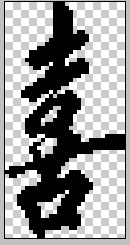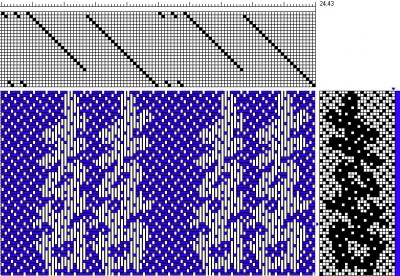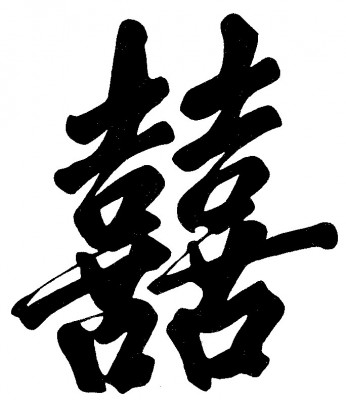I couldn’t sleep this morning (my body wakes me up at 5-6am regardless of when I went to sleep) so I decided to play around with drafts while waiting for everyone else to get up. I started playing with a very blocky double-happiness symbol, thinking that would be easier to manage:
 It’s a symmetric design, which means that instead of using 24 shafts for the whole symbol, I could use 24 shafts for half the symbol and just repeat it, enabling me to make the symbol larger, about 48 threads wide. At my typical sett (40-45 epi) that would be just over an inch wide, easily large enough to read.
It’s a symmetric design, which means that instead of using 24 shafts for the whole symbol, I could use 24 shafts for half the symbol and just repeat it, enabling me to make the symbol larger, about 48 threads wide. At my typical sett (40-45 epi) that would be just over an inch wide, easily large enough to read.
However, I quickly decided I didn’t like the blocky look. It didn’t have any of the organic flow that I associate with Chinese calligraphy, and I thought it was just plain ugly.
So I grabbed a prettier version from the Internet:
I chose this image in part because I liked the calligraphy, but primarily because it would cut in half gracefully. To capture the calligraphic image in an attractive manner, I needed as many shafts as I could get, and cutting it in half would effectively double the number of shafts I could use.
Then (following Alice Schlein’s Woven Pixel techniques) I reduced the cut-in-half version to an image about 30 pixels wide and 60-odd pixels tall, figuring I could fiddle with the long horizontal stroke to reduce the number of shafts later:

Following Bonnie’s advice, I decided to fill in the foreground with long floats (to accentuate the symbol, since long floats catch the eye) and the background with short floats. So, following Alice’s techniques, I used Photoshop to fill in the character with an eight-shaft satin pattern and the background with a four-shaft broken twill.
I made some other adjustments (mostly removing long floats and “cleaning up” the image) and finally arrived at this:

Notice how I crammed the two images together in the threading to produce the double-happiness symbol, and repeated the plain broken twill to space the double-happiness symbols apart.
I’m very pleased with the resulting draft. Thank you, Alice, for writing The Woven Pixel! It’s a really powerful technique that’s allowing me to do some very interesting things with imagery.


Tien,
Beautiful draft, and I look forward to seeing it woven some day. Thanks for the nice comments on The Woven Pixel. I just want to remind everyone that Bhakti Ziek and I wrote the book together, and all credit goes to her as well. She is a genius for structure, as well as an extraordinary artist and teacher.
Alice
Neato! I was drinking out of a double happiness coffee mug the other morning!
-d